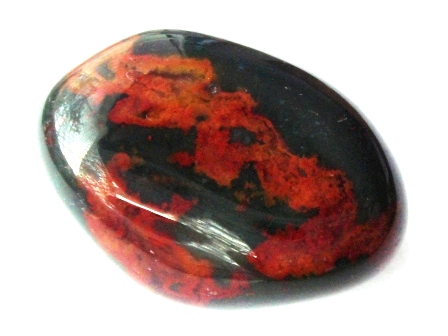Bloodstone, long considered the birthstone of March, is jasper speckled with iron oxide. (Months were assigned stones and gems from the high-priest’s breastplate of Aaron in the Old Testament or the gems described as the foundations of the New Jerusalem in the Apocalypse, the “Revelation of St. John.”)
Bloodstone was used to heal blood disorders and stop bleeding noses and wounds in Babylon and was carved into amulets to protect against the Evil Eye. Ancient Greeks thought using it in ritual would hasten changes in fortune. Western European Christians in the Middle Ages thought all bloodstones had been splashed with Christ’s blood at the Crucifixion and used the stones to carve images of either the Crucifixion or scenes of martyrs’ deaths.
These gems would be pulverized and mixed into egg whites with honey and used to remove poison from snakebites. Knights and soldiers would bring bloodstones with them into battle not only to staunch bleeding but to increase courage and physical strength as well. It was also thought to confer invisibility, a useful skill in battle. It was also used as an aphrodisiac (useful after battle).
Some also associate aquamarine gems with March. This gemstone was believed to protect sailors, as well as to guarantee a safe voyage. The serene blue or blue-green color of aquamarine is said to cool the temper, allowing the wearer to remain calm and levelheaded.
In the Middle Ages, many believed that the simple act of wearing aquamarine was a literal antidote to poisoning. The Romans believed that if you carved a frog into a piece of aquamarine jewelry, it would help to reconcile differences between enemies and make new friends.
In some times and places, an aquamarine was given to the bride at her wedding in order to symbolize long unity and love. Some believed it could re-awaken love between two people; maybe that’s why it is also associated with a couple’s 19th anniversary?
The Sumerians, Egyptians, and Hebrews all admired aquamarine, and many warriors would wear it into battle to bring about victory. Many ancient medicines used powder from aquamarine to help cure all manner of infection, but it was said to be particularly good for eye ailments.

Since early times, aquamarine has been believed to endow the wearer with foresight, courage, and happiness. It is said to increase intelligence and make one youthful. As a healing stone, it is said to be effective as a treatment for anxiety and in the Middle Ages it was thought that aquamarine would reduce the effect of poisons.




